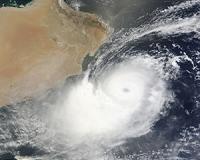 |
Pasadena CA (SPX) Dec 21, 2010 New technologies developed by NASA and other agencies are revealing surprising insights into a major earthquake that rocked parts of the American Southwest and Mexico in April, including increased potential for more large earthquakes in Southern California. At the fall meeting of the American Geophysical Union in San Francisco, scientists from NASA and other agencies presented the latest research on the magnitude 7.2 El Mayor-Cucapah earthquake, that region's largest in nearly 120 years. Scientists have studied the earthquake's effects in unprecedented detail using data from GPS, advanced simulation tools and new remote sensing and image analysis techniques, including airborne light detection and ranging (LiDAR), satellite synthetic aperture radar and NASA's airborne Uninhabited Aerial Vehicle Synthetic Aperture Radar (UAVSAR). Among their findings: + The earthquake is among the most complex ever documented along the Pacific/North American tectonic plate boundary. The main shock activated segments of at least six faults, some unnamed or previously unrecognized. It triggered slip along faults north of the border as far as 165 kilometers (about 100 miles) away, including the San Andreas, San Jacinto, Imperial and Superstition Hills Faults, and many faults in California's Yuha Desert, some not previously mapped. Some of this slip was quiet, without detectable earthquakes. Activity was observed on several northwest-trending faults due for potentially large earthquakes. + The rupture's northern end in Southern California resembles the frayed end of a rope. The complex, 32-kilometer (20-mile) network of faults that slipped there during and after the earthquake-- many unnamed or previously unrecognized--reveals how the earthquake distributed strain. + Satellite radar, UAVSAR and GPS station data show additional slip along some of the Yuha Desert faults in the months after the main earthquake. Recent data from UAVSAR and satellite radar show this slip slowed and probably stopped in late summer or early fall. + Mexico's Sierra Cucapah mountains were, surprisingly, lowered, not raised, by the earthquake. + The main rupture jumped an 11-kilometer (7-mile) fault gap-more than twice that ever observed before. + UAVSAR and satellite radar reveal deep faulting that may be a buried continuation of Mexico's Laguna Salada Fault that largely fills the gap to California's Elsinore Fault. This could mean the fault system is capable of larger earthquakes. A connection had only been inferred before. + Analyses show a northward advance of strain after the main shock, including a pattern of triggered fault slip and increased seismicity. The July 7, 2010 magnitude 5.4 Collins Valley earthquake on the San Jacinto Fault may have been triggered by the main earthquake. + Forecasting methods in development suggest earthquakes triggered by the main shock changed hazard patterns, while experimental virtual reality scenarios show a substantial chance of a damaging earthquake north of Baja within three to 30 years of a Baja quake like the one in April. "This earthquake is changing our understanding of earthquake processes along the Pacific/North American plate boundary, including earthquake physics, forecast modeling and regional faulting processes," said Professor John Fletcher of the Center for Scientific Research and Higher Education at Ensenada (CICESE), Baja Calif., Mexico. Fletcher led a multi-agency Mexico fault mapping effort that included the U.S. Geological Survey and California Geological Survey, among others. UAVSAR, developed by NASA's Jet Propulsion Laboratory, Pasadena, Calif., uses a technique called interferometric synthetic aperture radar to measure ground deformation over large areas to a precision of 0.1 to 0.5 centimeters (0.04 to 0.2 inches). A NASA Gulfstream III aircraft carrying the radar flew repeat GPS-guided passes over the California border region twice in 2009 and four times since the April earthquake, imaging it and continuing deformation since. Field mapping since April has demonstrated its ability to show remarkable surface rupture detail. "UAVSAR is blanketing California's seismic danger zones about every six months to detect changes such as earthquakes or creeping faults," said JPL Geophysicist Eric Fielding. "The major earthquake in Baja last April is providing direct evidence that time-critical monitoring of hazardous faults is possible through NASA-funded technology." "The accurate and detailed imagery derived from synthetic aperture radar, and in particular UAVSAR, produced a more complete picture of fault patterns, precisely guiding field geologists to remote areas of fault rupture and saving significant mapping time," said geologist Jerry Treiman of the California Geological Survey, Los Angeles. JPL geophysicist Jay Parker said UAVSAR's precise images are adding realism to NASA's QuakeSim crustal models and forecasts. "Once we have these precise measurements of the changing landscape, we use them to deduce changes in stress that accelerate or delay the next major earthquakes, with the help of structural models and forecasting tools," he said.
Share This Article With Planet Earth
Related Links UAVSAR QuakeSim Earth Observation News - Suppiliers, Technology and Application
 Satellites Give An Eagle Eye On Thunderstorms
Satellites Give An Eagle Eye On ThunderstormsMadison WI (SPX) Dec 17, 2010 It's one of the more frustrating parts of summer. You check the weather forecast, see nothing dramatic, and go hiking or biking. Then, four hours later, a thunderstorm appears out of nowhere and ruins your afternoon. Thunderstorms can bring intense rain, hail, lightning and even tornadoes, but "predicting them a few hours out is one of the great problems of meteorology," says Chian-Yi Liu, ... read more |
|
| The content herein, unless otherwise known to be public domain, are Copyright 1995-2010 - SpaceDaily. AFP and UPI Wire Stories are copyright Agence France-Presse and United Press International. ESA Portal Reports are copyright European Space Agency. All NASA sourced material is public domain. Additional copyrights may apply in whole or part to other bona fide parties. Advertising does not imply endorsement,agreement or approval of any opinions, statements or information provided by SpaceDaily on any Web page published or hosted by SpaceDaily. Privacy Statement |